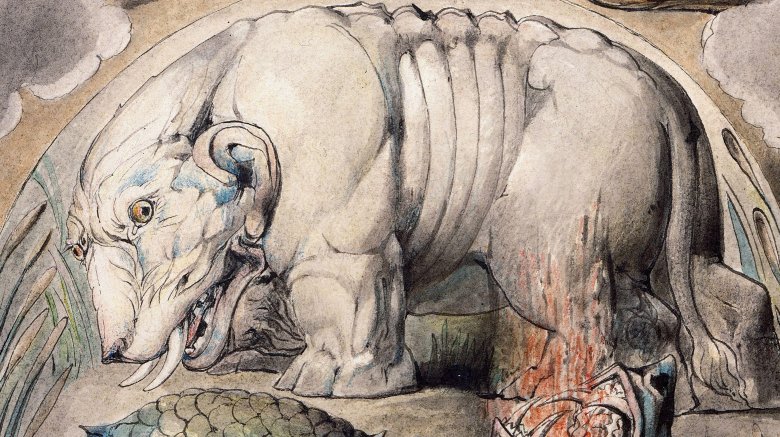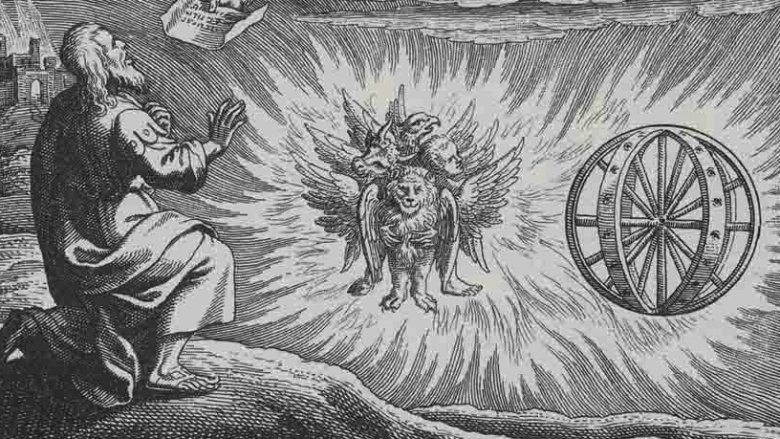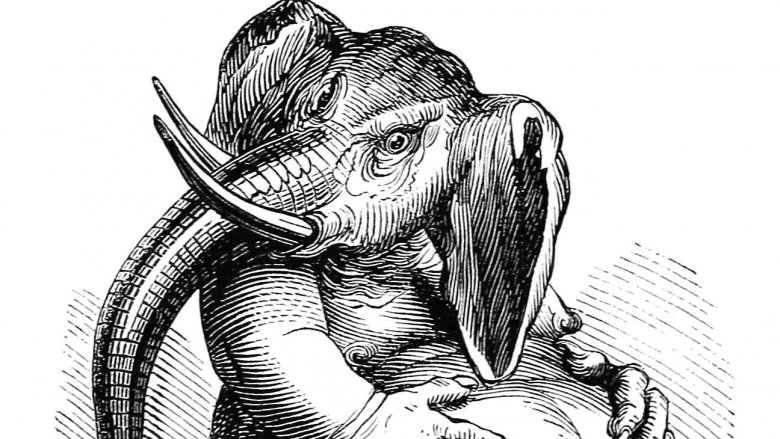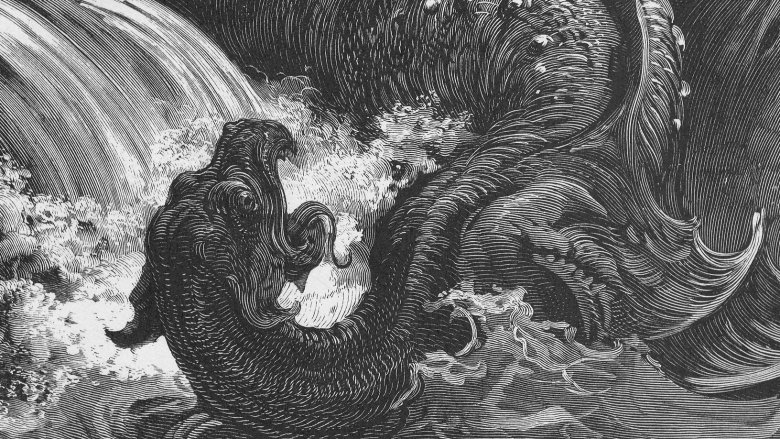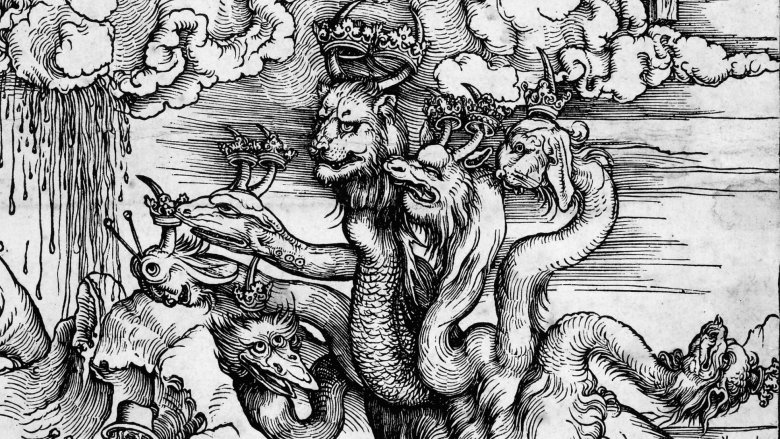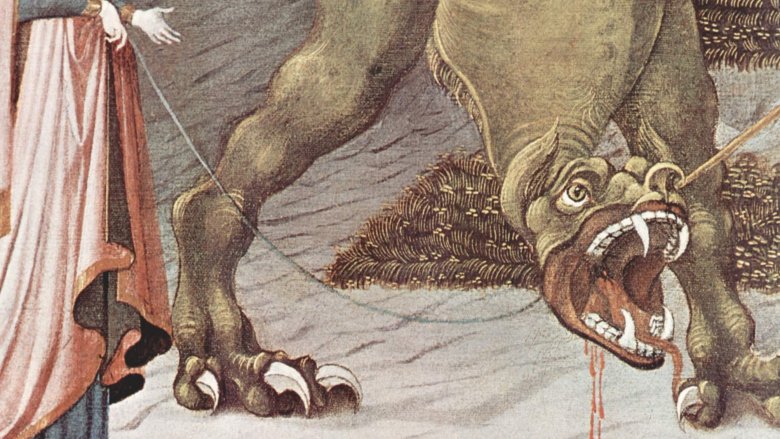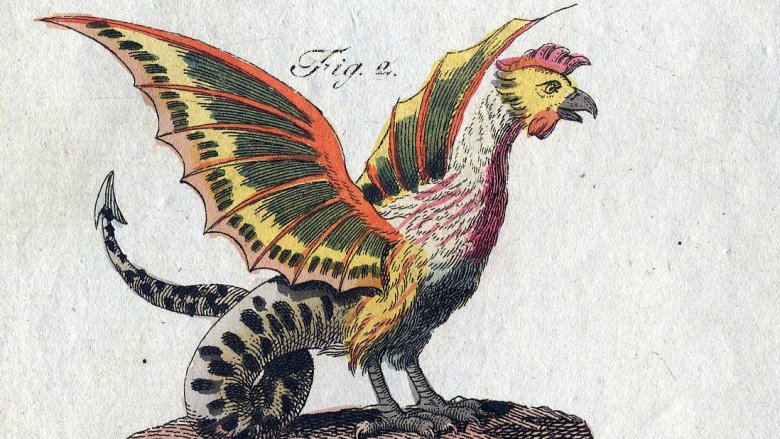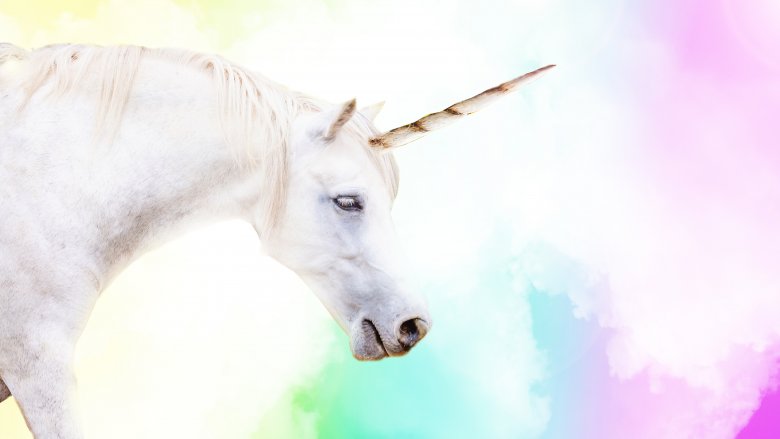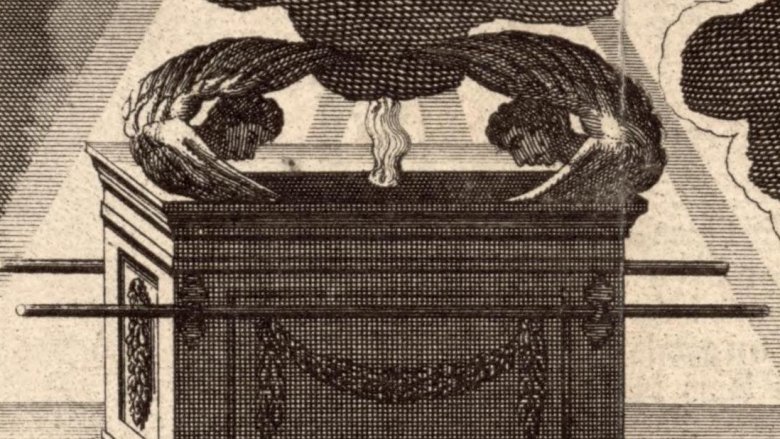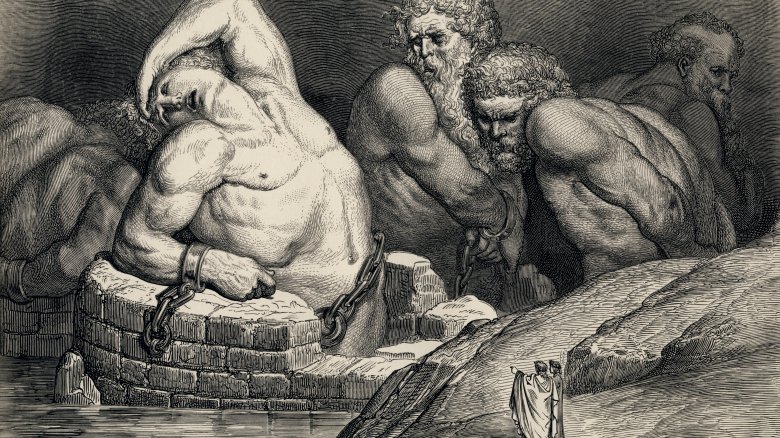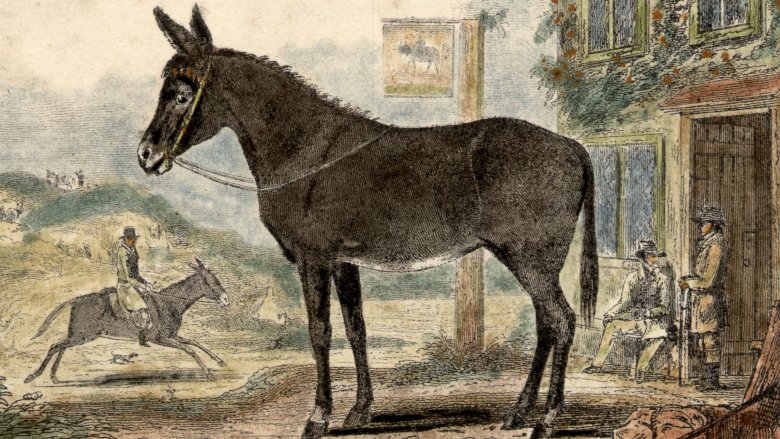The Craziest Creatures Described In The Bible
We may receive a commission on purchases made from links.
No matter what you're looking for, you can probably find it in the Bible. A story about a guy making a couple of bears kill 42 children because they called him bald? That's in the Bible. Need a reason to kick people with weird feet out of church? Look no further than the Bible. It's a remarkably long book written and rewritten by dozens of different people over several centuries. It's almost impossible to keep track of everything contained inside the Good Book.
With all the offbeat surprises hidden in the Big Book, it should come as no surprise that the Bible bestiary gets wonky at times. Sure, there are the animals that everybody remembers: Noah's floating menagerie of just everything, Jonah's whale, the lions in the den. But then there are the other guys. Strange, sometimes confusing creatures that would have even the best-read Sunday School teacher wondering whether they picked up a copy of Fantastic Beasts and Where To Find Them by mistake. Here are some of the craziest creatures you'll find in the Bible.
Ophanim
It's sort of common knowledge at this point that those white-lady-with-wings angels that we all grew up with don't appear anywhere in the Bible. Angels are more of a culturally accepted shorthand than a straightforward adaptation of the source material. So why did artists across the centuries decide to depict the heavenly host as white-garbed, blonde-haired bird women and not the way they were described in the text?
The answer might fall somewhere between "because the angels from the Bible would be harder to draw on church ceilings" and "because if you saw pictures of what angels were supposed to look like, you'd mess your Depends." By way of example, take the Ophanim first described in Ezekiel 1:15. In Jewish tradition, there are ten orders of angels, and the Ophanim are considered some of the most holy, second only to the Chayot Ha Kodesh who hold the throne of God. And brother, they're bananas. There's a lot to go into, and parts of the description come off a little like a fever dream, but essentially Ophanim are flaming gyroscopes covered in eyes, guarding God's seat of power.
Behemoth
The Behemoth is one of a handful of creatures in the Bible that historians have been arguing about for quite a while. Scholars can't agree on much about this puppy, but they know two things: He was big, and he had a belly button.
The Book of Job describes the Behemoth as a giant, reed-dwelling creature that's too powerful for anyone except God to control. Depending on the interpretation, it could drink an entire river, and its strength was significant enough to be worth mentioning four times in a single paragraph. But besides "big" and "strong," the closest thing we get to a descriptor is a line about how "his force is in the navel of his belly," meaning that, contrary to what some Young Earth enthusiasts believe, whatever Job was describing probably wasn't a dinosaur since animals that hatch from eggs are usually short on navels.
So what could the Behemoth have been? Most modern literal interpretations point to either a hippo or an elephant, but there's also some debate as to whether it was just a metaphor for the power of God.
Leviathan
The second creature described in the Behemoth passage of Job is the Leviathan, and where the Behemoth leaves quite a bit of wiggle room for visual interpretation, the Leviathan is bizarrely well fleshed out, to the point of making the Behemoth seem like an unloved afterthought. No, really. Job goes into staggering detail describing all of the wildly upsetting aspects of this creature's body.
Whereas the Behemoth is considered "the Beast of the land," the Leviathan calls the water his domain. It has double-thick armor plating running down its back and muscular folds all over its body. It breathes fire. Its skin is impenetrable, tough as stone. It is, in summation, hard core rock and roll. Its name is synonymous with the unknowable, terrifying sea creatures that old sailors used to tell stories about, and that map makers marked on their maps with warnings of danger: "There be monsters here."
As with the Behemoth, the Leviathan has been the subject of plenty of debate over the years. Unlike the Behemoth, however, the language used to describe it doesn't leave a lot of room for poetic license. While people have theorized that it may have been a crocodile or a particularly crabby whale, it's a little difficult to square that with "fire breathing rock monster."
The First Beast of Revelation
If books of the Bible were kids in an eighth-grade class photo, the Book of Revelation would be the one with too many safety pins in its sweatshirt and an X-Acto knife that he stole from art class stashed in his back pocket. Let's take a look inside his diary and see what sort of weirdness he's been cooking up.
The descriptively named First Beast is laid out for the reader in Revelation 13:1. Also called the Beast of the Sea on account of its oceanic point of origin, it sports a flirty summer look featuring ten horns with crowns on top of them, "the name of blasphemy" written across all seven of its heads, the feet of a bear, and the mouth of a lion. It's also described as taking a lethal beating to one of its heads before miraculously healing itself, which apparently makes it very popular, since after that "all the world wondered at the beast."
The First Beast pops up again a few pages later in Revelation 17:7-18 when an angel pops its head in to explain that the creature was a metaphor for mountains, and also a metaphor for kings, and also Revelation has never been the easiest nut to crack, you know?
The Second Beast of Revelation
Revelation's Second Beast is a mysterious son of a gun. Introduced at roughly the same time as Beast No. 1, this shady fella emerges from the Earth in what you have to assume is a pretty dramatic spectacle. It has the voice of a dragon! It has the horns of ... a lamb. It has, one would assume, other qualities as well, but that's about as much as we're told about the thing's physical makeup.
The Second Beast acts as sort of a hype man for the First Beast. In Revelation 13:11-16, it's seen convincing human beings to worship the First Beast, pulling stunts like making the sky rain fire. It also has the dubious honor of acting as Satan's tattoo artist, branding the hands or foreheads of its followers with the "mark of the beast," an enigmatic physical sign indicating fealty to the forces of darkness. There's no mention of whether or not this is its way of compensating for its only remarkable feature being a pair of lamb horns, which rank pretty low in terms of intimidation factor on the list of possible horns to have.
Dragons
Next on our tour of mythological Bible creatures with nebulous, potentially medieval origins is the dragon. The King James Bible clocks 34 different mentions of dragons, which is pretty undoubtedly a matter of creative translation. Some are just allusions lending themselves to colorful hyperbole, like when Deuteronomy says that "wine is the poison of dragons" and Micah 1:8's poetic "Therefore I will wail and howl, I will go stripped and naked: I will make a wailing like the dragons, and mourning as the owls." But again, Isaiah comes riding in with some literal monsters to slay.
According to Chapter 13 of Isaiah, after Babylon falls, its palaces will be infested by dragons, as well as "doleful creatures," owls, and even satyrs. Dragons appear again in Chapter 34, where they take up residence in another city that's Hulk-smashed by the wrath of the Almighty.
Things get even more intense in Revelation, as they tend to do. There we see that Satan takes the form of a great red dragon, fighting angels in a heavenly battle royale. In a stunning upset, one particular angel lays on a smackdown and banishes the creature to the bottomless pit for a thousand years.
It's worth noting that of the many uses of "dragon" in the King James Bible, 17 are derived from the Hebrew word "tanniyn," which is alternately translated as "whale" in Genesis 1:21 and "sea monsters" in Lamentations 4:3, making it kind of a catch-all for "big, intimidating animal."
Cockatrice
Rounding out the list of Bible animals that seem more at home in a D&D campaign than in scripture is the cockatrice. It shows up three times in the King James translation of the Book of Isaiah, generally in foreboding passages and descriptions of the works of evil men, all of which leads to one important question: What is a cockatrice?
For the benefit of the more outdoorsy kids in the crowd, a cockatrice was a mythological creature that was a lot more popular in the Middle Ages than it is these days. It was a sort of low-key dragon; a winged, two-legged serpent with a rooster's head. They reportedly appeared when a rooster (remember, that's a boy chicken) laid an egg that was left to be cared for by a toad or a snake a la Horton Hatches An Egg.
As fun as it is to imagine weird chicken snakes on Noah's ark, all signs point to the inclusion of the cockatrice being a strangeness particular to medieval translations. While the King James Bible brings it up, other versions have a killjoy habit of interpreting the Hebrew root word "tsepha" as "adder" or "viper."
Daniel's angel
Physical descriptions of angels are few and far between in the Bible, but when they happen, things get full on prescription-strength bonkers. In Chapter 10 of the Book of Daniel, the eponymous Daniel was going through a rough patch. He was three weeks deep in a period of mourning in which he didn't bathe, drink wine, or eat "pleasant bread." Around that time, an angel came to him, and lo, it was heavy on showmanship. As Daniel put it:
"I looked up and there before me was a man dressed in linen, with a belt of fine gold from Uphaz around his waist. His body was like topaz, his face like lightning, his eyes like flaming torches, his arms and legs like the gleam of burnished bronze, and his voice like the sound of a multitude."
To recap: a guy with a crystal body and an electric face shot fire out of his eyes and spoke with the voice of a crowd. Probably for the best that he opened with the classic "be not afraid" line.
Unicorns
In a twist that will come as a shock to anyone who didn't listen to that Irish Rovers song growing up, yes, there are unicorns mentioned in the Bible. It just sort of depends on which Bible you read.
See, the Bible is funny. A lot of it has been interpreted and reinterpreted hundreds of times in just about every language, including Klingon. Different societal situations at different points in time have yielded wildly diverse understandings of what the original text meant, with some words having more than one meaning and others having no direct translation at all. Sometimes, blanks needed to be filled in.
And that's one explanation for why the King James Bible, first printed in the early 17th century, mentions unicorns not once but nine separate times. They're generally used as a point of reference for a simile, but that changes in the Book of Isaiah. In Chapter 34, God is on a hot streak, cutting down sinners with a sword filled with blood and ram kidneys. It's foretold that while this happens, unicorns and bulls will overrun the land of Idumea and lay the place to waste.
Cherubim
Everybody knows a cherub when they see one. They're the pudgy, loveable Cupids sprinkled around staff rooms in confetti form around mid-February every year. Unless, that is, you read the source material, in which case they skew a little more toward terrifying chimera than pinchable angel toddlers.
As described in Ezekiel, the cherubim are an angelic order with a lot going on, physically. They each have four faces, for starters, including a human one, an ox, an eagle, and a lion. Each one of them had four wings, too, as well as straight legs capped at the end with shiny bronze bull hooves. They're traditionally given a series of heavenly duties, maybe most famously guarding the gates of Eden. In some traditional Jewish teachings, they're considered the ninth highest order of angels, and associated with the task of helping people move beyond their sins in order to be closer to God, and for fans of raiding lost things, they're also what's described as being sculpted onto the lid of the Ark of the Covenant in Exodus.
As with lots of Biblical creatures, the cherubim have shifted visually over time. As popular art changed, they became thematically intermingled with the Greek/Roman god of love and are now visually synonymous with the lovable winged babies we're all familiar with.
Nephilim
In Genesis, shortly after Adam and Eve were eighty-sixed from the Garden of Eden, people started getting on with the business of making more people. While a lot of that went down about the way you'd expect, there were some glaring irregularities as well. It was a hectic point in the Biblical timeline, and a lot of strangeness gets ever so slightly swept under the rug, at least in terms of the things they teach in Sunday School.
Exhibit A: The Nephilim. In Genesis Chapter 6, it's relayed that "the sons of God," usually interpreted as fallen angels, noticed that the daughters of man (read: ladies) were looking pretty all right. The angels got hitched to human brides, and the resulting progeny were the Nephilim, a race of violent giants. How giant is giant? In Numbers they're described as being roughly to people what people are to grasshoppers. So, you know. Big. The Book of Enoch, an apocryphal religious text that didn't make the final cut of the Bible, said they were nearly a mile high. They're also considered to have been symbolic of the corruption God felt he needed to wipe out with the Great Flood.
Talking animals
There are two prominent talking animals in the Bible. The first is a gimme: In Genesis, Eve is tempted by a snake with more interest in her nutritional intake than you tend to see in a standard reptile. The second one you might not have heard of, and it gets pretty funky.
In Numbers, we meet Balaam, a troubled prophet. Long story short, Balaam is on a road trip, and he really had to needle God about it in order to get the Lord's permission to go. God gives him the go-ahead but doesn't feel great about it, so he sends an angel to mess with the donkey Balaam is riding. The angel, invisible to Balaam, freaks the donkey right out, making it veer off course and smack Balaam against a wall. Balaam gets angry at the donkey and smacks it around. That's when God gives the donkey the power of speech. The donkey asks Balaam why he got so slap happy, and Balaam, apparently unphased by the fact that he's sitting on a sentient barnyard animal, says something along the lines of "because you're being very uncool about this whole 'me riding you' thing."
At this point, the angel shows himself to Balaam and says that if the donkey hadn't been pulling evasive maneuvers, the angel would've killed Balaam by now. Balaam repents, goes about his business, and apparently never checks back in on the whole "I own a talking barnyard animal" development.
